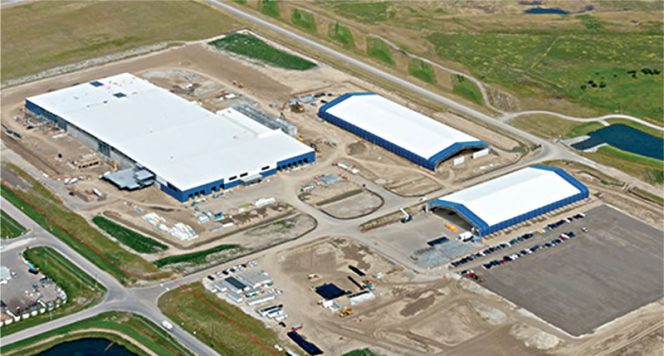BioCycle August 2017
Calgary, Alberta: 521,000 Sq. Ft. Composting Facility Opens
Construction of the 521,000-sq.ft. composting facility in Calgary started in fall 2015 at a cost of $143 million. The facility is now open to accept all of Calgary’s food waste and yard trimmings from single-family homes, collected via the City’s curbside green cart program. “The pilot that we operated for the last five years has shown us that there is great support for this program,” Philippa Wagner, green cart implementation leader with the City of Calgary, told Global News Canada.
The facility uses aerated tunnels based on the Maple Reinders/Christiaens Group technology, similar to the system in Hamilton, Ontario that opened in 2006. The Calgary facility has 18 tunnel reactors, a capacity of close to 160,400 tons/year and a total processing time of 60 days. Households will be charged CN$6.50/month (US $5.15/mo.) for weekly pick up when the fee goes into effect in January 2018. Biosolids from the city of Calgary’s wastewater treatment plant will also be composted at the facility.
Raleigh, North Carolina: Bulk Compost Dealer Locator Map
The North Carolina Composting Council (NCCC) introduced the North Carolina Bulk Compost Dealer Locator Map (the “NC Bulk Compost Map”) at its Annual Members Meeting in June. The map connects North Carolina residents and landscapers with retail locations selling compost in bulk quantities (i.e., by the cubic yard). Retailers in the state selling compost in small bag quantities, such as garden centers and hardware stores, have traditionally been easier to find than those selling compost in bulk quantities. The NCCC partnered with CompostNow to develop the new NC Bulk Compost Map. WRE-Earth Farms and McGill Premium Compost assisted in sponsoring this updated tool. The map shows over 150 retailers selling compost in bulk quantities from various compost manufacturers throughout North Carolina.
The primary goal of the updated map, explains Jorge Montezuma, organics recycling specialist with the state’s Recycling Business Assistance Center, is to expand the availability of bulk compost and increase the awareness and use of compost in North Carolina. The map includes existing permitted composting facilities that also sell bulk compost directly to the public, as well as retailers. The map’s features include search by zip code, contact information, compost manufacturer, USCC’s STA (Seal of Testing Assurance) approval, and OMRI organic certification.

Richgro’s (New Zealand) Loadscan volumetric scanner
Hamilton, New Zealand: Soil Blenders Track Load Volumes
Central Soils, part of a New Zealand landscape supply company in Hamilton, screens excess topsoil stockpiles left over from subdivision developments into a fine fluffy mix that is then sold to landscape yards and composting facilities in the Waikato and Auckland area. Because royalty payments are made to the owners of the topsoil based on per cubic meter volumes, Central Soils purchased a portable Loadscan volumetric scanner (LVS-3BMP) designed to measure materials bought and sold by volume, including compost and soils.. The scanner enables Central Soils to measure the quantity of topsoil in each load, produce reports for the owners and make payments based on a trade certified volumetric measurement. It is also used to bill customers for the quantity of product supplied, which helps resolve disputes with customers that believe they may have been short supplied. The unit’s portability aids in situations where Central Soils has to move its scanning locations.
Richgro, an Australian manufacturer of premium garden products, including compost, installed two load volume scanner units (LVS) configured in a one-way traffic route at a production facility near Perth. One LVS measures the inbound loads and the second is used to scan and measure outbound bulk supplies to customers. The two units run the Loadscan synchronized database software that enables sharing of the reference (database) scans of each truck. For example, a truck not currently registered in the database can be scanned first with a full load by the inbound scanner, then unloaded and scanned empty at the second scanner to obtain the volume measurement of the fully laden truck.
Zagreb, Croatia: Biodegradation Of Imidacloprid By Composting
Researchers from the Croatian Ministry of Agriculture and the University of Zagreb evaluated how composting can degrade imidacloprid, a common insecticide that was made to mimic nicotine. Nicotine is naturally found in many plants, including tobacco, and is toxic to insects. Imidacloprid is used to control sucking insects, termites, some soil insects, and fleas on pets. It has been used in products sold in the United States since 1994. There are over 400 products for sale in the U.S. that contain imidacloprid.
Imidacloprid is a systemic insecticide, which means that plants take it up from the soil or through the leaves and it spreads throughout the plant’s stems, leaves, fruit, and flowers. Insects that chew or suck on the treated plants end up eating the imidacloprid as well, which damages their nervous system and eventually causes them to die. Imidacloprid persists for months or years in soil. The residues become more tightly bound to the soil with time. Imidacloprid is broken down rapidly by water and sunlight. The pH and temperature of water affect the speed of the imidacloprid breakdown process. Imidacloprid may leach from soil into groundwater under some conditions.
The researchers evaluated imidacloprid degradation in both a forced aeration closed reactor and in an open static pile, using a mix of fresh vegetable waste, tobacco waste, dry leaves and a bacterial suspension of Pseudomonas aeruginosa FN (a bacterial strain known to degrade nicotinoid compounds). The mix had an initial C:N ratio of 23:1, which decreased to 16:1 at the end of the 21-day composting process, and an initial moisture content of 55 percent. In the closed reactor system, the bulk of the imidacloprid degradation occurred in the first 7 days, when 68 percent of the pesticide was degraded. The half-life of imidacloprid in the reactor was measured at 5.13 days. Degradation in the open pile was much slower, with a calculated half-life of 27.88 days. This research appeared in the December 2016 issue of Chemical Papers.
St. Lucie County, Florida: Commercial Composting Zoning Ordinance
St. Lucie County adopted a zoning ordinance to address interests in developing commercial composting facilities in the county. Facilities will only be allowed in the County’s AG-5 zone (Agricultural, 5-acre minimum lot size) under a conditional use permit. Regulated feedstocks include biosolids, manures, food wastes, and mixed solid wastes, but not yard trimmings. Setback requirements are 300 feet from any property line and 1,320 feet from any nonapplicant owned or used building. Applicants must demonstrate the following:
• All operations take place in an enclosed building with negative air pressure and on an impervious floor with 1 x 10-7 cm/sec impermeability.
• Proposed facilities will not increase nutrient or pathogen loadings to county streams and rivers.
• All contact water and/or leachate will be appropriately treated by permitted treatment plant.
• Site is able to control and treat runoff from a 100-yr, 72-hr storm.
Operational constraints include mandated 15-foot aisles between piles and maximum pile height of 15 feet. Performance bonds are also required, varying from $200,000 to $4 million, depending on facility capacity.











